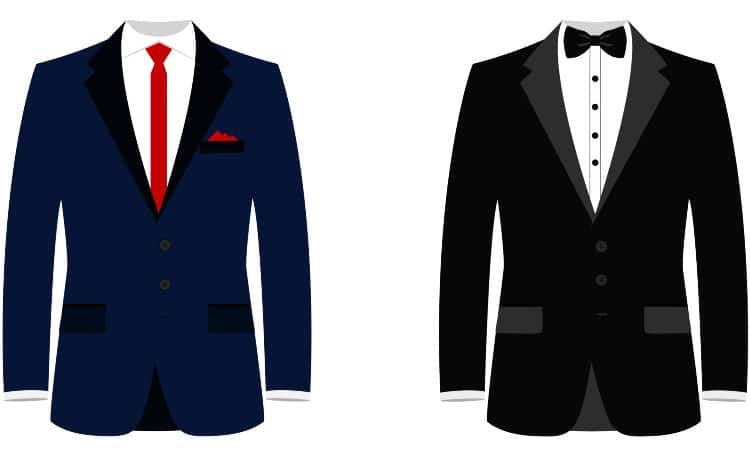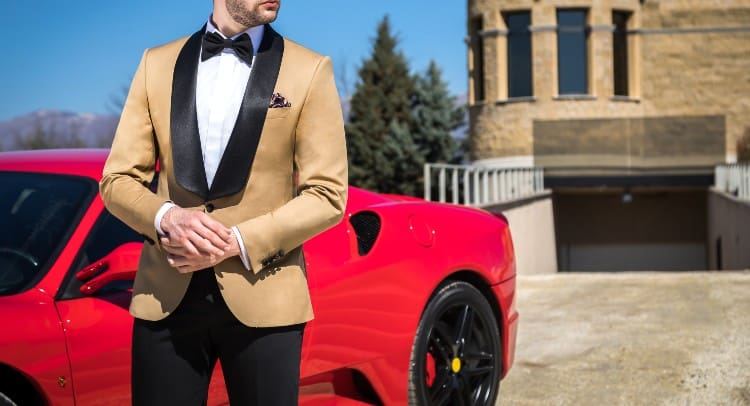It may seem like guys get it easy when picking an outfit for prom or a wedding. It looks simple because formal menswear mostly consists of a simple jacket and pants, but it actually has its own set of rules and challenges! For example, when you compare a suit vs a tuxedo, what exactly is the difference between them?
The biggest difference between a suit and a tuxedo is that a tuxedo features details in black satin. This gives a tuxedo a more formal appearance than a suit. While a suit can pair well with shirts in varying colors, a tuxedo goes best with a white shirt that often features black buttons and pleats or ruffles.
In this article, you will learn the key characteristics of both suits and tuxes. You will discover the differences between these two types of menswear. Finally, you will find tips on when and how to wear each one!
Quick Navigation
What is a Suit?

A suit consists of a matching jacket and trousers, often paired with a dress shirt and tie. The type of jacket and trousers most often worn to the office or a special event today is technically a lounge suit. While you may think of a suit as the peak of formality for menswear, it falls into the classification of business wear or semi-formal attire at best in most cases.
The word “suit” comes from a French word, suivre, which means “follow.” Most likely, the word became associated with a suit because this outfit always involves a jacket and pants that use the same fabric in the same color. You can wear a sports jacket with a pair of trousers and look pretty snappy, but in this case, you are not technically wearing a suit!
Though a suit always consists of a matching jacket and pants, the cut or style of these two garments can vary enormously.
The earliest “lounge suit” as we think of it today, harkens back to a famous fashion expert in the 1800s named Beau Brummell. This icon almost single-handedly revolutionized menswear and became one of the first celebrity clothing influencers!
This led to the popular “frock coat” worn by men in Victorian times. While this coat had a much longer length than you would expect from a men’s jacket today, it often paired with matching trousers, leading up to the modern lounge suit.
By the early 1900s, the upper class had developed multiple types of men’s jackets and suits, each meant to be worn at certain events or even at certain times of the day. The lounge suit, with its matching jacket and trousers, originated as a casual outfit to wear while hanging outdoors or dropping in to visit a friend.
Throughout the 20th century, the suit remained the most popular type of menswear for the middle and upper classes. Style details like the length of the jacket, the shape of the lapels, and the placement of pockets varied a lot over the century, but the general idea remained pretty consistent.
It is important to note that the purpose of the lounge suit did change in the mid-20th century, however. At this point, it shifted from a set of casual attire meant for a gentleman to wear while inspecting his estate to the mandatory uniform of the businessman. A wall street executive did not wear a blazer to his office in the 1950s–he wore a matching suit!
Modern suits have a more fitted shape than the matching pants and jackets worn in the 1950s or 60s. For instance, modern pants tend to have a tapered leg instead of the boxy, flapping legs you would have seen in the 1930s or 40s. But despite that, the basic concept of the suit does not look all that different than it has for over a hundred years!
What is a Tuxedo?

A tuxedo is a special type of menswear consisting of a jacket and pants with satin detailing. The most popular style of tuxedo consists of a black jacket with a shawl-style lapel and matching black pants, typically worn with a crisp white tuxedo shirt beneath the jacket. Today, the tuxedo is the most popular kind of menswear for weddings, black tie events, and proms.
In America, you will see this formal attire called a tuxedo or tux. In other parts of the world, a tuxedo jacket often goes by the name “dinner jacket.”
This is because the tuxedo originated in a traditional British outfit called the smoking jacket. In the 1800s, gentlemen would retire to a separate room to smoke and chat after formal dinners. The semi-formal velvet or satin jackets the upper class often wore to these dinners became known as smoking jackets because of this practice.
King Edward VII kicked off the trend of the tuxedo as we know it today, though, as he made famous a style of tailless jacket, complete with silk details, to a dinner party. At the time, this tuxedo-like jacket had a much less formal appearance than the more traditional dinner clothing!
So, why is this iconic style called a tuxedo today? The name comes from a place called Tuxedo Park in Hudson Valley. A wealthy coffee investor named James Brown Potter gets the credit for visiting England and bringing back this style of jacket. Brown-Potter held dinner parties at his home in Tuxedo Park, which is how the outfit got its name.
Despite that, the tuxedo probably would not have earned its place as the outfit for formal occasions if it wasn’t for a woman wearing it in a shocking and scandalous way. In the 1930s, Marlene Deitrich brought the tux back into the spotlight quite literally when she famously wore a tuxedo in a movie called Morocco.
Following this, the tuxedo developed into its own matching jacket and pants style, rather than an unmatched dinner jacket worn separately. It remained popular throughout the 20th century as black-tie attire for men and as a statement of rebellion and feminism for women.
Today, you can find tuxedo styles in black, blue, and white jackets and trouser sets, though black fabric with black satin detailing remains the most popular.
Suit vs Tuxedo: Key Points
| Suit | Tuxedo | |
|---|---|---|
| Formality | Perfect for formal, semi-formal, and business casual events. The style and color of the suit and the accessories you choose can dress it up or down. | Always formal, with a timeless and elegant style appropriate for black tie events. |
| Style | Available in many colors and cuts. You can wear them with many different kinds of shirts and a variety of shoe styles as well. | Tuxes almost always feature black satin detailing and a shawl lapel. They pair best with white shirts and black patent leather shoes. |
| Buttons | The number and type of buttons vary. | Tuxes usually have one or two satin-covered buttons. |
| Material | Suits come in many different kinds of material, though wool is one of the most common. | Tuxedos almost always feature black satin detailing around the lapel, at the pocket opening, and down the outseam of the trousers. |
| Cost | Around $300-$600 for a good suit, or $60-$80 for a cheap suit. | About $700-$1,000 to buy a tux, though you can rent one for about $130. |
| Best Used For | Formal events in the morning, semi-formal events, and the workplace. | Black-tie events or formal events that happen in the evenings. |
What is the Difference Between a Suit and Tuxedo?

The biggest difference between a suit and a tuxedo is that a tux has a fancier style because it always features satin detailing. While suits can work in a formal setting, they typically have a slightly less elegant appearance than tuxedos.
Formal or Informal
Both suits and tuxedos can work in a formal setting, but suits also work well in semi-formal or business casual settings, while tuxedos only appear at special events and black-tie occasions. This is because the tux has become the accepted black-tie uniform for men at almost all formal events, such as award ceremonies, dance, and weddings.
This is not to say that a men’s suit does not also look formal. You can find evening suits in a three-piece style that cut a very dashing and elegant line and would certainly not look out of place in wedding photos! But most of the time, the classy black satin details in a tux make it the better choice for a formal event.
On the other hand, the suit remains the outfit of choice for the office. You would feel very out of place wearing a tux to your cubicle!
Style
The biggest stylistic difference between suits and tuxedos is that tuxedos often feature a special type of lapel and suits can vary in color more than tuxes.
The lapel on a suit jacket or tuxedo jacket is the long folded-over piece running from the neck down the opening of the garment. Many suit jackets feature notch or peak lapels. A tuxedo jacket usually has a shawl lapel, which has a long, continuous shape that runs from the hem of the jacket, around the back of the neck, and back down the other side.
Many suit jackets have lapels in the same fabric as the body of the suit. On a tux, you will always see the shawl lapel in a decorative, shiny black satin.
Another stylistic difference between suits and tuxes is that suits come in far more colors and cuts. You can buy a casual linen suit for wearing on a yacht, a traditional three-piece suit with a vest to wear to a christening at a church, or a standard two-piece suit in almost any color imaginable to wear to the office.
On top of this, you also see a lot of style variation in the elements of clothing commonly paired with a suit and tuxedo. For example, you can wear dress shirts in various colors with most suits. A blue wool suit might match nicely with a pink or grey cotton button-down shirt, for example. But a tuxedo pairs only with a white shirt, sometimes featuring black buttons or vertical pleats.
Finally, you also traditionally wear certain accessories with a tuxedo, such as a cummerbund and a bow tie. While you can wear a bow tie with a suit, it is more common to wear a long tie. You also almost always wear a tux with black patent leather shoes, while you can pair a suit with loafers or other types of footwear.
Buttons
Tuxedo jackets always feature one or two satin-covered buttons, but suit jackets can have a varying number of buttons.
Most of the time, tuxes have just one button. Instead of a plastic or horn button, a tux button usually has a neat padded covering of black satin to help it blend in with the lapel of the jacket. You do sometimes see tuxes with two buttons, but this is still a contrast to a suit jacket that can have anywhere from one to four buttons.
Different styles of suit jackets will have different amounts of buttons. For example, a double-breasted suit jacket will often have four buttons. Plus, you can get suits with buttons made out of plastic, resin, horn, or wood. Typically, bespoke suits will use natural materials, while cheaper suits will feature plastic buttons. You do not often see suits with buttons covered in fabric.
Material
The main difference in the material used in suits and tuxes is that tuxedos always feature detailing in black satin. This holds true even if you get a white, blue, or red tux–the details such as the lapel, the pocket opening, and the lining will almost always feature black satin.
Besides that elegant decoration, you can find both suits and tuxes made out of a wide variety of types of cloth.
Off-the-rack suits at your average department store will usually contain cheap polyester fabric. High-end brands will offer a range of wool, cotton, and linen suits, often with silky lining inside the jacket. For a truly outstanding suit, you can purchase a bespoke number from a gentleman’s shop or a tailor and select the fabric you like before ordering the suit.
If you go to a tuxedo rental, most of the off-the-rack numbers you find there will probably contain a cheap synthetic fabric. Because of this, style experts recommend buying one good-quality tuxedo tailored to fit your particular body shape and ideally containing nice fabric such as wool. Since tux styles do not change a lot, you can count on wearing that one outfit to most of the black-tie events you attend for years to come!
Cost
Tuxedos usually cost more than suits, though this depends heavily on the brand and the type of material used. Buying a tuxedo made of good-quality material usually costs between $700-$1,000. A suit from a reputable brand usually costs between $300-$600.
Of course, you can rent a tux for about $130-$150 for a special event if you do not want to commit to such a big purchase. You can get off-the-rack suits made more cheaply from places like Walmart or Target, which will only set you back about $60-$80.
Why do nice tuxes cost more than nice suits? The price difference often comes down to the expensive materials used in a tux. Plus, you commonly either order a custom-made tux or at least get the outfit fitted, so that it looks tailored to your body. This personalization adds to the cost as well.
Best Used For
Suits are best used for wearing to morning and afternoon formal events or the workplace. Tuxedos work best for formal or black-tie occasions. Of the two styles, suits have far more flexibility.
You can dress up a suit to wear to a fancier event, but you can’t dress down a tux for an informal event! You can find out more on when you should and should not wear a tux in the section on “when to wear a tux vs a suit” later in this article.
Are Suit and Tux Measurements the Same?
Suits and tuxes use the same set of measurements. If you own a suit that fits you perfectly, you can check the label and then order a tux in the same size!
That said, it’s always a good idea to take your measurements before making a big purchase, such as a tuxedo. Your size may have changed slightly since the last time you bought a suit. Plus, different brands and clothing manufacturers use slightly different metrics to determine sizing, so the size you wear in one brand may not fit the same in another brand!
Key measurements you may need when fitting yourself for a suit and a tux include chest, waist, arm length, and inseam.
Tuxedo Trousers vs Suit Trousers
The biggest difference between tuxedo trousers and suit trousers is that tuxedo trousers usually feature a black satin stripe down the outer leg. Suit pants usually do not have any extra decoration.
Plus, suit pants often have belt loops around the waistband. Tux pants do not use belt loops; instead, they will feature waist adjustor straps on the inside of the waistband. In some cases, tuxedo pants will also have a black satin waistband.
The cut of the pants can vary for both suits and tuxes. Trendy suits often have more fitted, tapered legs. This holds true for tuxedos as well. Depending on your preference, you can choose a looser or a more tapered fit.
When to Wear a Tux Vs a Suit

Now that you know the key differences between a tux and a suit, check out this handy guide to help determine when you should wear a suit and when you should wear a tux!
Can You Wear a Suit Instead of a Tuxedo?
In most cases, you can wear a suit instead of a tuxedo, though a tuxedo remains the most acceptable menswear for black tie events. That said, you can wear a good-quality black suit paired with a white shirt and a bow tie to many formal occasions without causing a stir.
Suits offer a lot of flexibility. You can wear a suit to the office, a party, a high-end bar, and fancy-dress events like parties and weddings.
Tuxedos have more limitations as you pretty much only wear them to formal events.
Can I Wear a Suit to a Black Tie Event?
Most of the time, you should not wear a suit to a black tie event. If you receive an invitation to a black-tie event, the standard dress code requires that you wear a tuxedo, white shirt, bow tie, and black patent-leather shoes.
Of course, modern fashion also values individualism, so you can mix things up if you feel brave enough! For instance, many younger people wear a nice black suit with a bow tie to these events. This gives you a bit of a trendy and less formal edge.
Another thing to keep in mind is that traditionally, “black tie” describes a formal event that happens in the evening. “White tie” describes a formal event happening earlier in the day. White-tie events typically have a less formal dress code, featuring items like cocktail-length dresses for women and lounge suits for men.
Do Guys Wear a Tux or a Suit to Prom?
You can wear a tux or a suit to prom depending on the image you want to convey. It is acceptable to wear a suit or even a sequined blazer to your prom if that represents your fashion sense best! On the other hand, you can’t go wrong with a tuxedo because everyone will recognize your outfit as a classic, stylish choice for a fancy dance.
You may want to check with your date before making your choice, though. If your boyfriend plans to wear a suit, you may want to match him by also wearing a suit. Or, if your girlfriend plans to wear a super formal floor-length ballgown, you may match her outfit better if you splurge and get a tux!
Suit vs Tuxedo Wedding
The traditional rule for weddings is that men should wear a suit for a wedding that happens during the day and a tuxedo for a wedding that happens in the evening. This holds true for guests attending the wedding as well.
That said, while Emily Post might dictate these rules for wedding wear, you do have a lot more flexibility in your choice today. Plenty of bridal parties show up wearing a dress shirt and brocade vests, for example!
You and your partner should decide how formal you want the big day to look. If you (or your partner) love all the frills and fripperies and want a traditional wedding, you probably want to go the extra mile and wear a tux. But if you want a more laid-back ceremony, there is no reason you can’t select a nice suit instead.
Tuxedo vs Suit vs Blazer
The biggest difference between a tuxedo, a suit, and a blazer is the level of formality associated with each garment. Tuxedos have a very formal style, while suits can work for formal or semi-formal events. Blazers, in contrast, have the least formal appearance.
Traditionally, blazers and sports coats have a casual vibe as they stem from the traditional hunting jackets or outdoor apparel for the gentleman. Suits and tuxes have a history based on menswear for formal dinners or parties.
This means you can wear a blazer to the office, but maybe not to an interview. You can wear a suit to the office or an interview, but maybe not to your wedding. You can wear a tux to any black-tie event, but it is too formal to wear in a low-key setting.
Another key difference between blazers and suits or tuxes is that a blazer is a stand-alone jacket that you can pair with pants in a different color. Suits and tuxes both have matching jackets and trousers.
Conclusion
The main difference between a suit and a tuxedo is that tuxes feature black satin detailing on the jacket and pants. Another key difference is that tuxedos have a more formal appearance than most suits. Suits come in a huge range of colors and cuts, while tuxes traditionally come in black or in a limited range of colors like blue and white.
Generally speaking, you will want to wear a tuxedo to any black-tie event or any formal event in the evening. The tux is also the most traditional choice of menswear for a wedding. A suit makes a better choice of outfit for the office, a party, or a white-tie event.